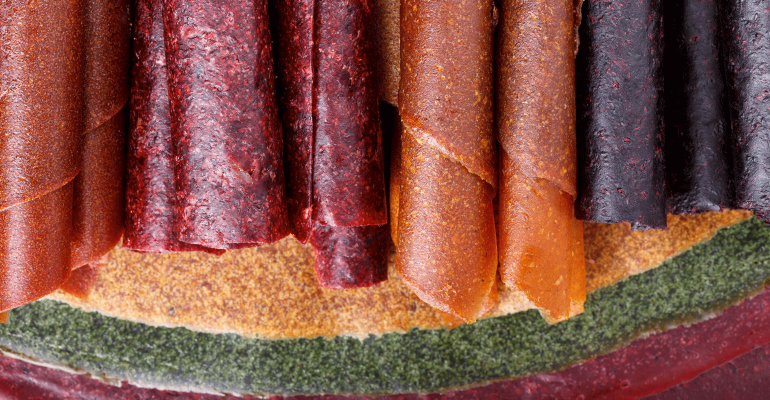Leather has moved off the catwalk and onto the menu.
No longer merely a chic fashion statement or desirable automotive upgrade, leather is also making the culinary scene. Fruit and vegetable leathers are turning up in many innovative treatments, as chefs add a distinctly contemporary twist to an ancient technique.
Dried fruits have historically been staples in Middle Eastern kitchens, where dates, figs and raisins were sun-dried and prized for their concentrated sweetness, portability and long shelf life. While they’re more likely to be dried in an oven or dehydrator today, leathers are still valued for the bright burst of flavor and pop of color they provide.
- Timna in New York City specializes in modern Israeli/Mediterranean cuisine, and the menu has included surprises like Mediterranean sashimi made with cured tuna and served with green tabbouleh, tzatziki and beet leather.Lazy Bear in San Francisco delivers a contemporary American dinner-party experience to diners, who buy non-refundable tickets in advance. Once there, they may find themselves treated to duck rillettes in a quince fruit rollup.
- Four-unit Plan Check Kitchen + Bar in Los Angeles specializes in updated American comfort food, like the popular Plan Check Burger served with signature, trademarked ketchup leather that is promoted as an “innovative square of deliciousness.” Besides adding flavor, it’s smartly placed between the burger patty and bottom bun to prevent the latter from getting soggy.
- Plan Check has further deployed its dehydrator in specials like a South Eastern Pork Belly Burger with Sriracha leather. And for diners with a real leather fetish, the promotional SS PCB Burger boasted slices of both Sriracha and ketchup leathers.
- On the sweeter side, oven-dried berries are turning up from coast to coast, as with chile-coated strawberries at Lalito in New York City and dried blueberries that pop up in the couscous at Tusk in Portland, Ore. On a related note, Louisville Vegan Jerky Company offers a limited-edition Sweet & Sour Pineapple Jerky as part of its #FAKEAF retail line of meat-jerky substitutes.
- At Third Rail, a cocktail and jerky bar in San Francisco, meat jerky and mushroom jerky share space on the menu, where each is sold for $4 per ounce.
The boomlet in fruit and vegetable leathers goes hand in glove with the much bigger boom in meat jerky, another product that is all cut and dried. While they lack comparable protein power, leathers afford restaurateurs a unique and attractive merchandising hook that can really light up a plate.





